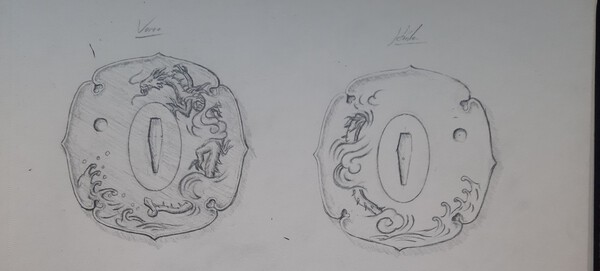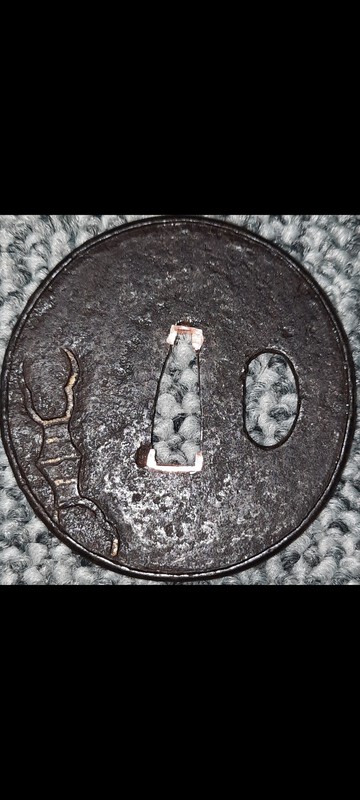
Haon
Members-
Posts
28 -
Joined
-
Last visited
Content Type
Profiles
Forums
Events
Store
Downloads
Gallery
Everything posted by Haon
-
Ive got to admit, now I am even more impressed by your work. I didnt think that simply removing the active rust would change the appearence in such an impressive way.
-
Thank you very much for your suggestion. While koshirae of that age would be great, I assume they are quite a bit rarer than blades from that era. I'm just focused on koshirae that was made with the intent of usage in mind, and not some fancy samurai-jewelry if it could be said that way.
-
Looks like a job well done. Did you only do the clean-up or did you also repatinate it? I really love the black surface. If you also treated the patina, may I ask how you achieved that?
-
Well, I am looking for exactly this. Most tachi I was able to find online are either in shirasaya or mounted in a fairly fancy way, which seems to special / expensive for actual use. I am aware of the change in weaponry over the time, but if there arent pictures there might be accurate descriptions to be found or known by some of you. Best regards, Haon
-
Thank you very much Mr. Hallam. I originally took a look at your patreon because of this project, but wasnt able to find something on kabutogane. However, I found many other intersting things there which are still an inspiration in my own jewelry and sometimes saved some projects of mine. Making a form was something I was afraid of and tried to avoid, but I guess there is nothing I can do to avoid that. While chasing and forging a small cup out of a sheet of silver or copper is something I did sometimes already, steel is something new to me. My current idea is to make such a small cup, and then forge it to its final shape on the form I made beforehand. If I may ask, does this sound like the correct way? Regarding the material thickness, I will begin with a 1,5mm steel sheet. Nice to know, I havent heard of that term before. Well, I also dont speak Japanese, so...
-
Thank you very much for your advice. I'm indeed a goldsmith, however, I finished my apprenticeship just last year and such work is not of our daily business. Just as you said, a silversmith would have more experience with this. Thank you for your email, I'm sure some questions will come up from time to time. By the way, am I correctly under yhe assumption that you are from germany, too?
-
Thank you very much for the picture, that makes it easier to understand. I really thought they would have been thicker, especially those with engravings, I would have started with a material thickness of 1,5mm in iron... However, I can hardly see how those corners are forged, as I can hardly imagine that those won't fold up in any helpful way when bending the strip. Either if I forge the "sideskirts" first and then bend it to its U-shape, or the other way around. Maybe it's just me, and all problems solve themselves when I'm actually working on the piece. I marked the areas of my concern in your picture.
-
Ah, that website. Thanks for the link. For some reason I always find them on the 3rd page on Google or not at all. I will do that, now I've just got to order the material and propably ruin the first few tries :D
-
With the risk of getting lynched in my mind, I dont work on antique blades or koshirae. However, I'd like to know more about tosogu, and to make some new fittings for my iaito, one of which is a kabutogane, which I'm not quite sure how to make one. Deep drawing might be an idea, or forging one like a little cup and adding the ridges afterwards using different punches. Furthermore, are there any recordings of the thickness of iron tosogu like fuchi and kashira / kabutogane? Best regards, Haon Edit: if you have pictures of your fuchigashira, or just fuchi and a lone kabutogane, feel free to share them here, for inspiration. I wasn't able to find any thread regarding specifically tachi / handachi koshirae
-
Hi Spartancrest, than you for your opinion. The extra hole was meant to represent a pearl / a wish or dream the dragon was chasing. The dragon will be inlaid and engraved out of solver, the rest will be blackened mild steel. I actually thought about doing this without the waves, as this would give more presence and importance to the hole. What do you think? Also, thank you very mich to all of you who were so kind and shared some pictures out of their collection. I guess many hobbies have to develop, as I'm always dreaming about more stuff without being able to afford them :D
-
Hi Spartancrest, you are correct, the tsuba is supposed to be mounted on a tachi. Regarding the blade edge side of the guard, is there anything wrong with the sides I chose for the dragon? The little hole is not supposed to be a hole for a kozuka. The example you posted looks quite fitting, I wasn't able to find any tachi tsuba with animal depictions, but rather mostly with arabesque patterns.
-
Some of you might remember my other thread about tsuba from the kamakura era, and I qasnt able to come up with a design that was satusfactory to me. Therefore, I've decided to go with a tsuba that might be historically out of place, but at least I will like it. Below you can find what I came up with, and now I'm searching for further ideas. Feel free to drop some good looking photos of tsuba with dragons, regardless of age, outer shape, or materials. Best regards, Haon
-
I've recently stumbled upon a set of pictures of a koshirae, from which I wanted to replicate the colouring and as far as possible the style of hada these portrait, for jewelry. Now, I've tried my best of puck using normal shibuichi (75% copper, 25% silver) and shakudo (in my case 4,5% gold and 95,5% copper). After trying normal blackening with liver of sulfur, there was visible difference between the two alloys, but far far subtle, almost invisible if you didn't know it was there and didn't have the correct light. Now, could it be that either the amount of silver or the amount of gold was too low or too high? And what would you recommend to achieve something comparable to the picture? It doesn't have to be as striking as the example, but the difference ein colour should be clear. Of course, it could be that the reason was the non traditional patinating, but unfortunately I don't have the necessary ingredients, and haven't found a store in my proximity which sells them. Best regards, Haon
-
I have recently seen a pair of menuki depicting a winged dragon, which is something I haven't seen before on Japanese art. Is there a reason for that, or is this a special kind of dragon, as I wasn't able to find any real information about that, other than this might be a product of a chinese craftsman living in Japan, in the late 18th century. Below is an attached screenshot. Best regards, Haon
-
Thank you very much for your information, it was helpful but there are a lot of ideas and questions in my head, still. The wooden tsuba is an unusual piece, it looks incredibly awesome and cursed at the same time.
-
So, I'm currently designing a tsuba for myself, and I've decided to go with the shape of aoi gata, as it is supposed to be mounted on a tachi. Can you show me any pictures of tsuba from the late kamakura era, so after the mongol invasions, preferably with sukashi or animal engravings? I might be completely wrong on this one, but most articles I can find on the Internet are either really short /bear almost no information and repeat themselves after the third one. I understand that what I'm asking for is propably rare. Also, does anyone have high resolution pictures of the tsuba and hilt of the statue of Kusunoki Masashige? Best regards, Haon PS: the tachi this is for is a modern made piece, no nihonto will be touched during this process.
-
I have seen several tachi of which the tsuka wasnt covered in samegawa recently (below the ito), but with some fabric, propably silk I think. Furthermore, these pieces of farbic were looking fairly detailed and decorated, so what was their purpose? Maybe just a decorative style of koshirae, and what would it be called, if there is a name for it? Ofc I cant find any photos of it right now, but if I stumble upon one I will add it. Best regards, Haon
-
If it is possible to ship this to germany, I would like to male my interest known, too. Best regards, this a really beautiful painting
-
Oh ok, in that case I propably misread something. Thanks for the clarification, and the congratulations :D
-
Thanks a lot. Knowing it could be a jakushi piece is already something. The possibility that it was used on a blade makes it a bit more special to me. These are some really nice pictures of tsuba you posted here.
-
Thank you very mich for you input. The point of a broken blade would explain to me why the shinogi-ji changes so early after the habaki. Maybe also the chip in the blade. Regarding the kogatana, maybe someone can translate the name (if it is one)? It seems to have rusted far less heavy at the ha, so maybe it is a laminated construction, or it has a, now hardly to make out, hamon. Seems that way, the steel should rust less if it has a smaller grain structure.
-
As my other thread about my tanto and kogatana, I recently got myself my first old tsuba. Had to get myself something nice after finishing my goldsmith exams and thougt that a tsuba might be fitting. I'm sorry for the pun. However, I know nothing about this piece, except that it has a diameter of 69,4mm x 67,3mm and a thickness of 5mm at the rim. Is there any meaning behind the dragon and the (I guess" vajra, maybe especially in this combination? Can the age be guessed and might it be worth sending it away for a professional examination? Best regards Derek
-
So, a few months ago I got this "old" tanto in a bad shape. It has a severe chip on the edge the polish is more or less scratched, one scratch is fairly long and well noticeable, the others are really fine, and even in person hard to see. As general information, it has a motohaba of 28,4mm and a motokasane of 6,9mm, the nagasa is 22,65cm, with a saki-sori of roughly 5-6mm. The blade itself is mumei, and has a slight amount of niku. The habaki fits very well and seems to have been made for the blade, it is a genuine "double"-habaki made out of two pieces, and copper if I had to guess, as this has some small pieces of verdigris on the inside. The second one is a little signed kogatana, which I acquired shortly after the tanto, and I am curious to know if the signature is genuine, given the bad shape it is in. It is 2mm thick, 12,6mm wide, and has a nagasa of 11,8cm. I hope to get an age estimation for both, maybe eben an estimate on quality. Generally, just some more information than the nothing I know currently. Maybe one or both are worth getting restored if possible, or is there a possibility to get both estimated professionally? I live in Germany, if this helps. Also, no, I won't touch either of this with anything than a cotton rag and oil.
-
Material removal during skillful polishing
Haon replied to Haon's topic in General Nihonto Related Discussion
Thank you very much for your insight and expertise, I am trying to get a replica blade made of the Koryu Kagemitsu and wanted to have one that micght be handling as the original in its first shape. Of course, exact figures cant be given, as these are propably very small, maybe not even really measureable, if done skillfully. As some people here seem to be really experienced with polishing and nihonto, this forum was one of the first that came to my mind. -
For looks? Guardian to the viewer and tip downwards, maybe even place the whole thing at an angle that you don't look flat at the guard. For stability and practicability, as DTM72 already said, maybe the D-Guarf towards the kake itself for balance. Best regards






















